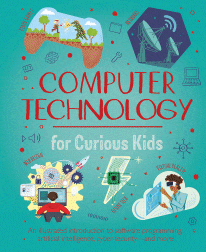
Computer Technology for Curious Kids
Computer Technology for Curious Kids
Chris Oxlade
Nik Neves
CSIRO Publishing, 2024
128pp., hbk., RRP $A32.99
9781486318360
It’s 1996, lunchtime in the library of a new government primary school in Canberra, and rather than the students you would expect to find there, there is a group of staff members lined up for their turn on the one computer that is linked to a local internet service via a dial-up line. It’s long before the department gets a LAN let alone a WAN, but these teachers are encouraged to be there by their enlightened, visionary principal (who has even hired an ICT coach for the teachers) as each one waits their turn to send an email to a colleague, to feel the thrill of having received one, and marvelling at this new way of doing business and its potential.
Fast forward nearly 30 years and nothing has moved quite as fast as the development of the technology and the impact it has had on the global community, even beyond. Now, instead of the wonder of email, encyclopedias on CD-ROM and being able to prepare a program without the trusty white-out on hand, we have terminology like artificial intelligence, smartphones, social media and cyber-security as part of our everyday vocabulary and our youngest students are participating in programming, playing video games and making movies using drones in a realm that was once reserved for the boffins and nerds.
So this new release from CSIRO Publishing in their Curious Kids series, is as much a journey through time as it is one of discovery. Taking the young reader on a trip that covers the history of computing, hardware and software components, data and apps, programming, communications and their ubiquity in daily life, this explains all sorts of things at their level of understanding, using text and illustrations that are straightforward but not overly technical or complex. For example, “image editing” is described as “editing photographs, perhaps to make then brighter or darker; to get rid of unwanted parts or to remove imperfections” followed by simple explanations and examples of the ways that people do this as they resize photos, or crop them to make the subject more prominent, or removing things like trees that seem to be growing out of a person’s head.
Similarly, the way computers are used to make life simpler, even being a central part of many of the toys and games the child plays with is explained as so many things are just taken for granted because they have always been in the child’s life, much as the telephone, radio and television were for previous generations. Just as their parents might not be able to recall a time when there wasn’t instant entertainment available in the room with the click of a remote, so too our little ones can’t imagine life without their friends and their activities being visible on a screen.
Whether this is a trip down memory lane for some, a way of understanding these “new-fangled computers” for others, and explanation of the how, what and why for those with a need to know, or the opening of a door to further explanation, this is a fascinating dip-and-delve book that has something or everyone.
